Australia's Monopoly Market: An Economic Study of Electricity Networks
VerifiedAdded on 2023/04/22
|9
|1962
|387
Essay
AI Summary
This essay examines the characteristics of a monopoly market structure in Australia, using the electricity network as a primary example. It discusses how the Australian electricity network, characterized by high infrastructure costs, operates as a natural monopoly, leading to higher electricity prices and industry inefficiencies. The essay compares the outcomes of a monopoly market with a competitive market, highlighting the deadweight loss and reduced consumer surplus. It also addresses government regulations and the role of entities like the Australian Energy Regulator (AER) and the Australian Competition and Consumer Commission (ACCC) in controlling market power and ensuring market efficiency. The analysis reveals that the high electricity prices and inefficiencies result from a combination of flawed regulatory systems and state ownership, rather than external factors. The essay concludes by emphasizing the importance of effective regulation to protect consumers and promote market efficiency in Australia's monopoly electricity network.
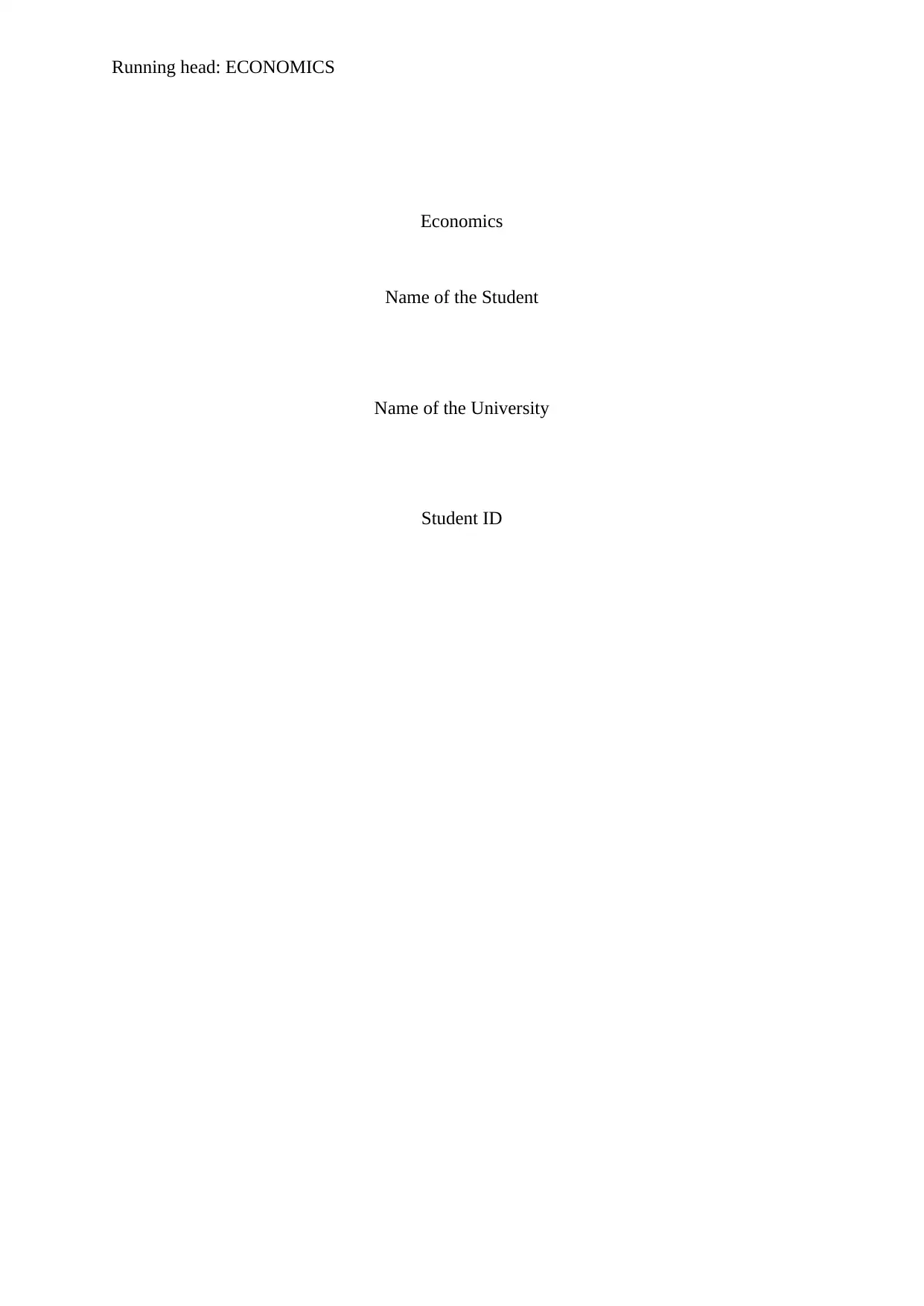
Running head: ECONOMICS
Economics
Name of the Student
Name of the University
Student ID
Economics
Name of the Student
Name of the University
Student ID
Paraphrase This Document
Need a fresh take? Get an instant paraphrase of this document with our AI Paraphraser
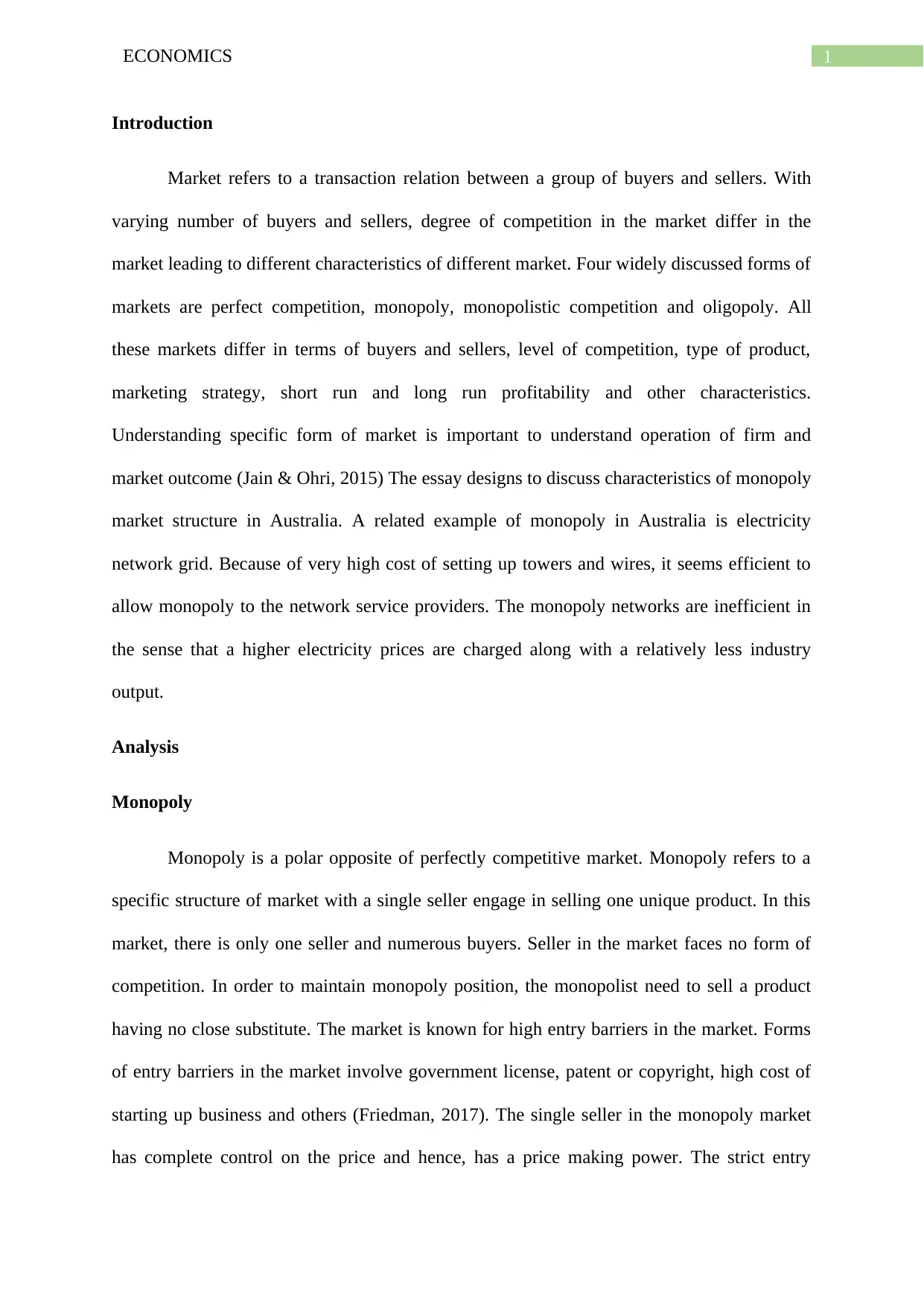
1ECONOMICS
Introduction
Market refers to a transaction relation between a group of buyers and sellers. With
varying number of buyers and sellers, degree of competition in the market differ in the
market leading to different characteristics of different market. Four widely discussed forms of
markets are perfect competition, monopoly, monopolistic competition and oligopoly. All
these markets differ in terms of buyers and sellers, level of competition, type of product,
marketing strategy, short run and long run profitability and other characteristics.
Understanding specific form of market is important to understand operation of firm and
market outcome (Jain & Ohri, 2015) The essay designs to discuss characteristics of monopoly
market structure in Australia. A related example of monopoly in Australia is electricity
network grid. Because of very high cost of setting up towers and wires, it seems efficient to
allow monopoly to the network service providers. The monopoly networks are inefficient in
the sense that a higher electricity prices are charged along with a relatively less industry
output.
Analysis
Monopoly
Monopoly is a polar opposite of perfectly competitive market. Monopoly refers to a
specific structure of market with a single seller engage in selling one unique product. In this
market, there is only one seller and numerous buyers. Seller in the market faces no form of
competition. In order to maintain monopoly position, the monopolist need to sell a product
having no close substitute. The market is known for high entry barriers in the market. Forms
of entry barriers in the market involve government license, patent or copyright, high cost of
starting up business and others (Friedman, 2017). The single seller in the monopoly market
has complete control on the price and hence, has a price making power. The strict entry
Introduction
Market refers to a transaction relation between a group of buyers and sellers. With
varying number of buyers and sellers, degree of competition in the market differ in the
market leading to different characteristics of different market. Four widely discussed forms of
markets are perfect competition, monopoly, monopolistic competition and oligopoly. All
these markets differ in terms of buyers and sellers, level of competition, type of product,
marketing strategy, short run and long run profitability and other characteristics.
Understanding specific form of market is important to understand operation of firm and
market outcome (Jain & Ohri, 2015) The essay designs to discuss characteristics of monopoly
market structure in Australia. A related example of monopoly in Australia is electricity
network grid. Because of very high cost of setting up towers and wires, it seems efficient to
allow monopoly to the network service providers. The monopoly networks are inefficient in
the sense that a higher electricity prices are charged along with a relatively less industry
output.
Analysis
Monopoly
Monopoly is a polar opposite of perfectly competitive market. Monopoly refers to a
specific structure of market with a single seller engage in selling one unique product. In this
market, there is only one seller and numerous buyers. Seller in the market faces no form of
competition. In order to maintain monopoly position, the monopolist need to sell a product
having no close substitute. The market is known for high entry barriers in the market. Forms
of entry barriers in the market involve government license, patent or copyright, high cost of
starting up business and others (Friedman, 2017). The single seller in the monopoly market
has complete control on the price and hence, has a price making power. The strict entry

2ECONOMICS
barriers have implications for short run and long run profits of the monopolist. The
monopolist can successfully earn profit which is above zero economic profit not only in the
short run but also in the long run.
Figure 1: Market outcome under monopoly
Network business monopoly in Australia
The electricity network in Australia is regarded as a market structure with similar
characteristics as a monopoly. In contrast to industries where it seems reasonable to allow
several firms to compete in the industry, in case of electricity grid, it is cost effective to let
one firm to supply electricity in the nation (Quiggin, 2017) In the national electricity market,
network businesses are monopoly while in wholesale and retail sectors are competitive.
The transmission networks in the electricity markets consist towers and wires that can
run between them, transformers, reactive power devices, underground cables, switching
equipment, telecommunication and monitoring equipment. All these assets are capital
intensive leading to a very high fixed cost for setting up electricity network. The considerable
high cost of electricity poles and associated wires imply that electricity network services can
barriers have implications for short run and long run profits of the monopolist. The
monopolist can successfully earn profit which is above zero economic profit not only in the
short run but also in the long run.
Figure 1: Market outcome under monopoly
Network business monopoly in Australia
The electricity network in Australia is regarded as a market structure with similar
characteristics as a monopoly. In contrast to industries where it seems reasonable to allow
several firms to compete in the industry, in case of electricity grid, it is cost effective to let
one firm to supply electricity in the nation (Quiggin, 2017) In the national electricity market,
network businesses are monopoly while in wholesale and retail sectors are competitive.
The transmission networks in the electricity markets consist towers and wires that can
run between them, transformers, reactive power devices, underground cables, switching
equipment, telecommunication and monitoring equipment. All these assets are capital
intensive leading to a very high fixed cost for setting up electricity network. The considerable
high cost of electricity poles and associated wires imply that electricity network services can
⊘ This is a preview!⊘
Do you want full access?
Subscribe today to unlock all pages.

Trusted by 1+ million students worldwide
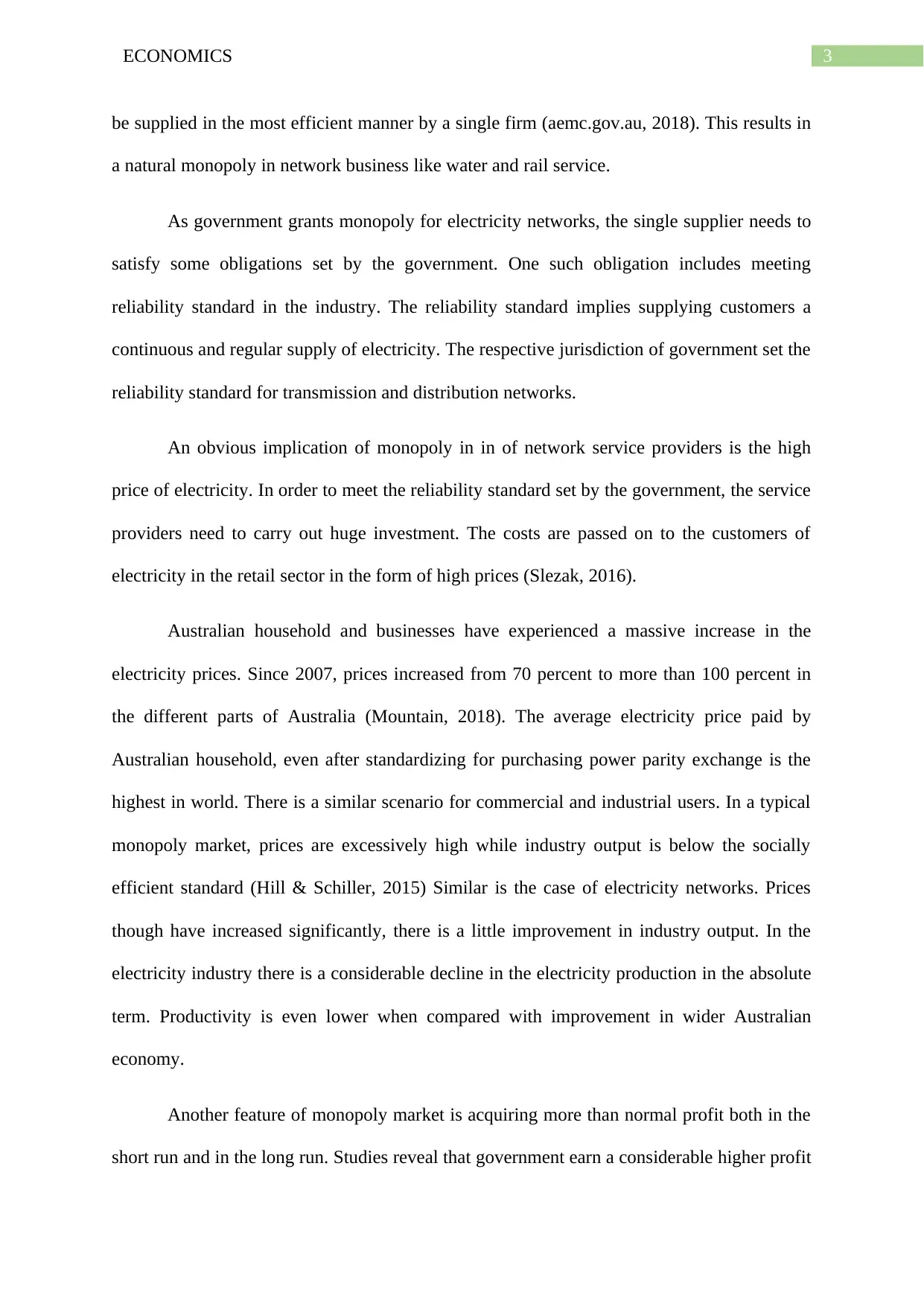
3ECONOMICS
be supplied in the most efficient manner by a single firm (aemc.gov.au, 2018). This results in
a natural monopoly in network business like water and rail service.
As government grants monopoly for electricity networks, the single supplier needs to
satisfy some obligations set by the government. One such obligation includes meeting
reliability standard in the industry. The reliability standard implies supplying customers a
continuous and regular supply of electricity. The respective jurisdiction of government set the
reliability standard for transmission and distribution networks.
An obvious implication of monopoly in in of network service providers is the high
price of electricity. In order to meet the reliability standard set by the government, the service
providers need to carry out huge investment. The costs are passed on to the customers of
electricity in the retail sector in the form of high prices (Slezak, 2016).
Australian household and businesses have experienced a massive increase in the
electricity prices. Since 2007, prices increased from 70 percent to more than 100 percent in
the different parts of Australia (Mountain, 2018). The average electricity price paid by
Australian household, even after standardizing for purchasing power parity exchange is the
highest in world. There is a similar scenario for commercial and industrial users. In a typical
monopoly market, prices are excessively high while industry output is below the socially
efficient standard (Hill & Schiller, 2015) Similar is the case of electricity networks. Prices
though have increased significantly, there is a little improvement in industry output. In the
electricity industry there is a considerable decline in the electricity production in the absolute
term. Productivity is even lower when compared with improvement in wider Australian
economy.
Another feature of monopoly market is acquiring more than normal profit both in the
short run and in the long run. Studies reveal that government earn a considerable higher profit
be supplied in the most efficient manner by a single firm (aemc.gov.au, 2018). This results in
a natural monopoly in network business like water and rail service.
As government grants monopoly for electricity networks, the single supplier needs to
satisfy some obligations set by the government. One such obligation includes meeting
reliability standard in the industry. The reliability standard implies supplying customers a
continuous and regular supply of electricity. The respective jurisdiction of government set the
reliability standard for transmission and distribution networks.
An obvious implication of monopoly in in of network service providers is the high
price of electricity. In order to meet the reliability standard set by the government, the service
providers need to carry out huge investment. The costs are passed on to the customers of
electricity in the retail sector in the form of high prices (Slezak, 2016).
Australian household and businesses have experienced a massive increase in the
electricity prices. Since 2007, prices increased from 70 percent to more than 100 percent in
the different parts of Australia (Mountain, 2018). The average electricity price paid by
Australian household, even after standardizing for purchasing power parity exchange is the
highest in world. There is a similar scenario for commercial and industrial users. In a typical
monopoly market, prices are excessively high while industry output is below the socially
efficient standard (Hill & Schiller, 2015) Similar is the case of electricity networks. Prices
though have increased significantly, there is a little improvement in industry output. In the
electricity industry there is a considerable decline in the electricity production in the absolute
term. Productivity is even lower when compared with improvement in wider Australian
economy.
Another feature of monopoly market is acquiring more than normal profit both in the
short run and in the long run. Studies reveal that government earn a considerable higher profit
Paraphrase This Document
Need a fresh take? Get an instant paraphrase of this document with our AI Paraphraser
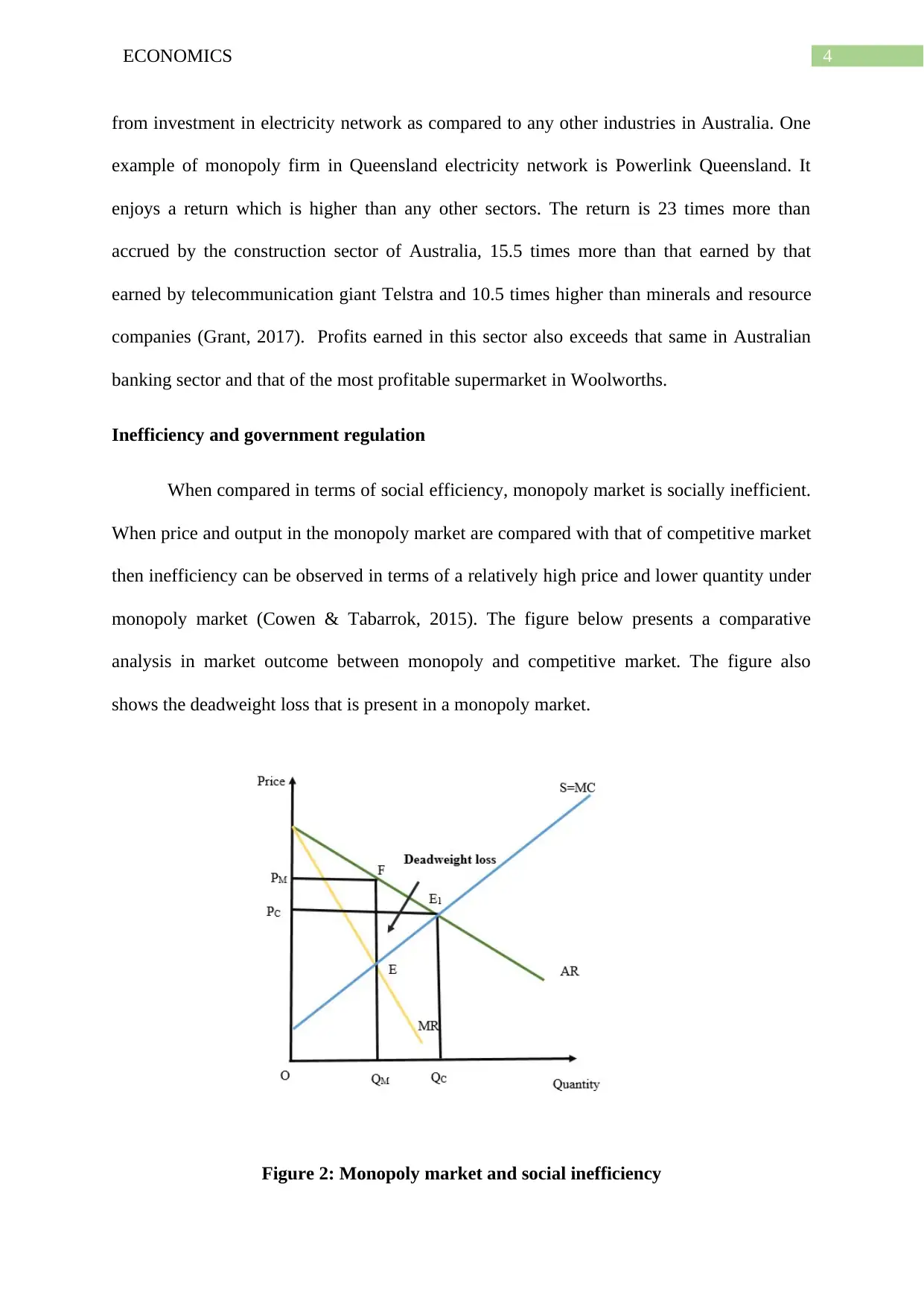
4ECONOMICS
from investment in electricity network as compared to any other industries in Australia. One
example of monopoly firm in Queensland electricity network is Powerlink Queensland. It
enjoys a return which is higher than any other sectors. The return is 23 times more than
accrued by the construction sector of Australia, 15.5 times more than that earned by that
earned by telecommunication giant Telstra and 10.5 times higher than minerals and resource
companies (Grant, 2017). Profits earned in this sector also exceeds that same in Australian
banking sector and that of the most profitable supermarket in Woolworths.
Inefficiency and government regulation
When compared in terms of social efficiency, monopoly market is socially inefficient.
When price and output in the monopoly market are compared with that of competitive market
then inefficiency can be observed in terms of a relatively high price and lower quantity under
monopoly market (Cowen & Tabarrok, 2015). The figure below presents a comparative
analysis in market outcome between monopoly and competitive market. The figure also
shows the deadweight loss that is present in a monopoly market.
Figure 2: Monopoly market and social inefficiency
from investment in electricity network as compared to any other industries in Australia. One
example of monopoly firm in Queensland electricity network is Powerlink Queensland. It
enjoys a return which is higher than any other sectors. The return is 23 times more than
accrued by the construction sector of Australia, 15.5 times more than that earned by that
earned by telecommunication giant Telstra and 10.5 times higher than minerals and resource
companies (Grant, 2017). Profits earned in this sector also exceeds that same in Australian
banking sector and that of the most profitable supermarket in Woolworths.
Inefficiency and government regulation
When compared in terms of social efficiency, monopoly market is socially inefficient.
When price and output in the monopoly market are compared with that of competitive market
then inefficiency can be observed in terms of a relatively high price and lower quantity under
monopoly market (Cowen & Tabarrok, 2015). The figure below presents a comparative
analysis in market outcome between monopoly and competitive market. The figure also
shows the deadweight loss that is present in a monopoly market.
Figure 2: Monopoly market and social inefficiency
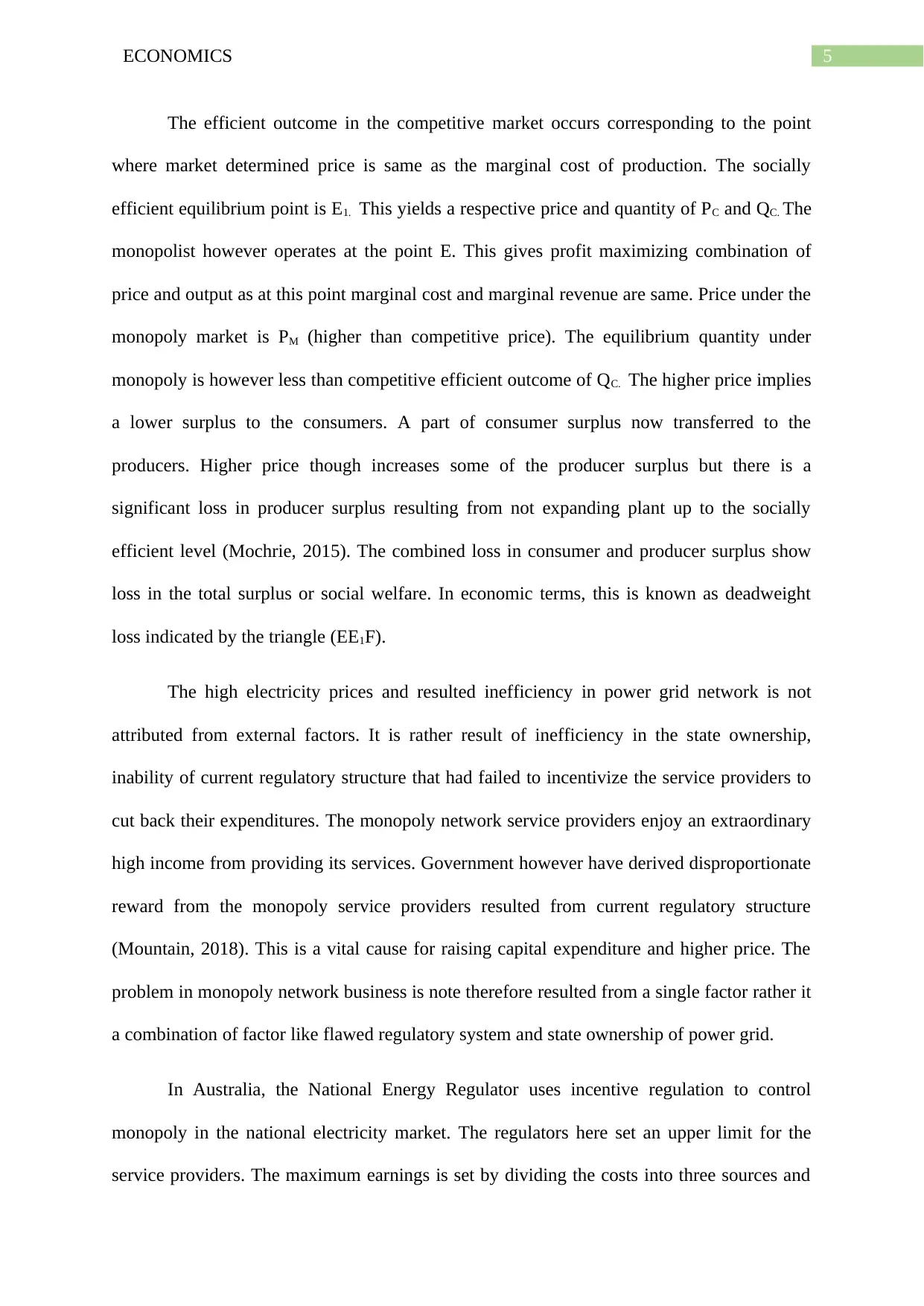
5ECONOMICS
The efficient outcome in the competitive market occurs corresponding to the point
where market determined price is same as the marginal cost of production. The socially
efficient equilibrium point is E1. This yields a respective price and quantity of PC and QC. The
monopolist however operates at the point E. This gives profit maximizing combination of
price and output as at this point marginal cost and marginal revenue are same. Price under the
monopoly market is PM (higher than competitive price). The equilibrium quantity under
monopoly is however less than competitive efficient outcome of QC. The higher price implies
a lower surplus to the consumers. A part of consumer surplus now transferred to the
producers. Higher price though increases some of the producer surplus but there is a
significant loss in producer surplus resulting from not expanding plant up to the socially
efficient level (Mochrie, 2015). The combined loss in consumer and producer surplus show
loss in the total surplus or social welfare. In economic terms, this is known as deadweight
loss indicated by the triangle (EE1F).
The high electricity prices and resulted inefficiency in power grid network is not
attributed from external factors. It is rather result of inefficiency in the state ownership,
inability of current regulatory structure that had failed to incentivize the service providers to
cut back their expenditures. The monopoly network service providers enjoy an extraordinary
high income from providing its services. Government however have derived disproportionate
reward from the monopoly service providers resulted from current regulatory structure
(Mountain, 2018). This is a vital cause for raising capital expenditure and higher price. The
problem in monopoly network business is note therefore resulted from a single factor rather it
a combination of factor like flawed regulatory system and state ownership of power grid.
In Australia, the National Energy Regulator uses incentive regulation to control
monopoly in the national electricity market. The regulators here set an upper limit for the
service providers. The maximum earnings is set by dividing the costs into three sources and
The efficient outcome in the competitive market occurs corresponding to the point
where market determined price is same as the marginal cost of production. The socially
efficient equilibrium point is E1. This yields a respective price and quantity of PC and QC. The
monopolist however operates at the point E. This gives profit maximizing combination of
price and output as at this point marginal cost and marginal revenue are same. Price under the
monopoly market is PM (higher than competitive price). The equilibrium quantity under
monopoly is however less than competitive efficient outcome of QC. The higher price implies
a lower surplus to the consumers. A part of consumer surplus now transferred to the
producers. Higher price though increases some of the producer surplus but there is a
significant loss in producer surplus resulting from not expanding plant up to the socially
efficient level (Mochrie, 2015). The combined loss in consumer and producer surplus show
loss in the total surplus or social welfare. In economic terms, this is known as deadweight
loss indicated by the triangle (EE1F).
The high electricity prices and resulted inefficiency in power grid network is not
attributed from external factors. It is rather result of inefficiency in the state ownership,
inability of current regulatory structure that had failed to incentivize the service providers to
cut back their expenditures. The monopoly network service providers enjoy an extraordinary
high income from providing its services. Government however have derived disproportionate
reward from the monopoly service providers resulted from current regulatory structure
(Mountain, 2018). This is a vital cause for raising capital expenditure and higher price. The
problem in monopoly network business is note therefore resulted from a single factor rather it
a combination of factor like flawed regulatory system and state ownership of power grid.
In Australia, the National Energy Regulator uses incentive regulation to control
monopoly in the national electricity market. The regulators here set an upper limit for the
service providers. The maximum earnings is set by dividing the costs into three sources and
⊘ This is a preview!⊘
Do you want full access?
Subscribe today to unlock all pages.

Trusted by 1+ million students worldwide
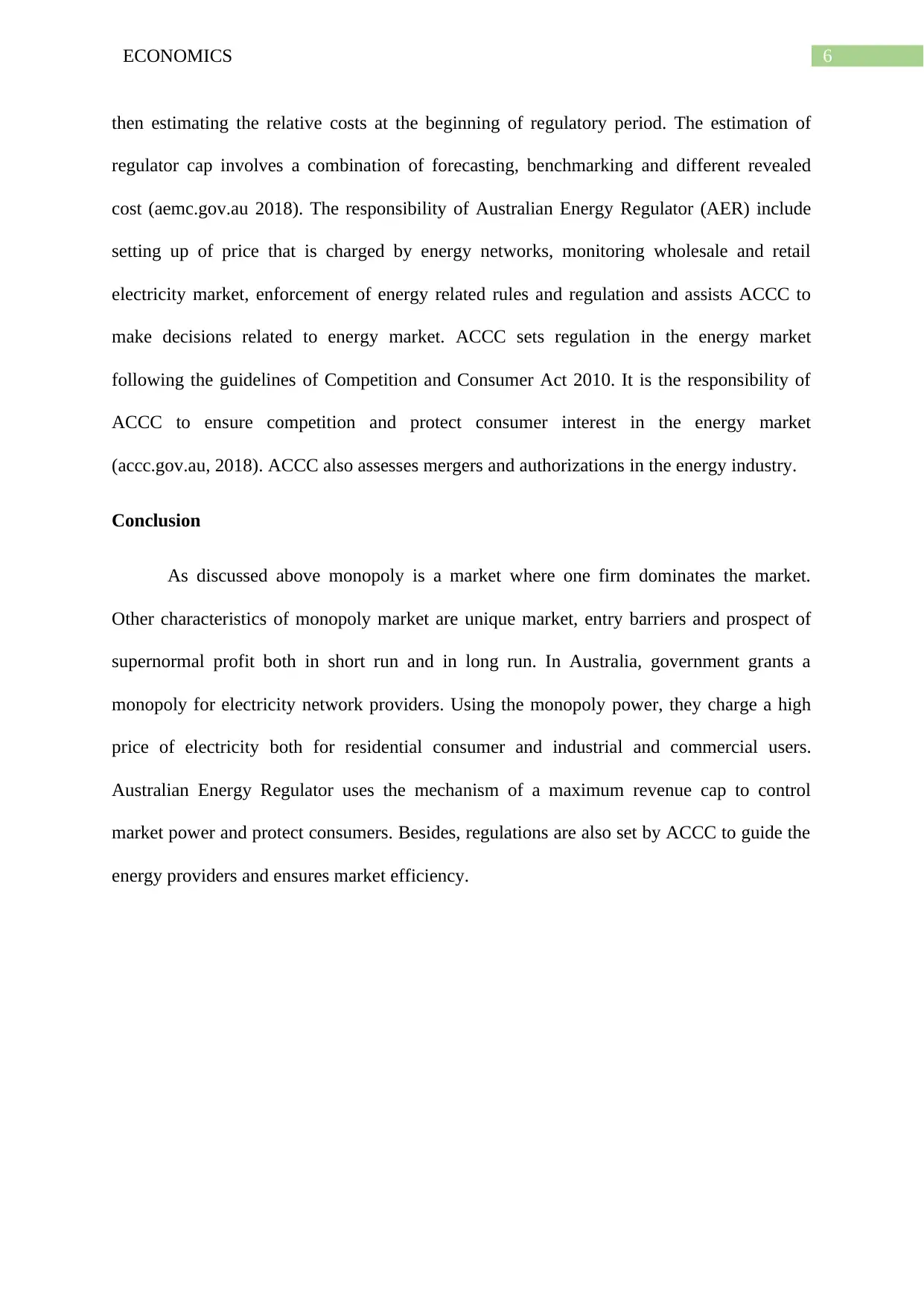
6ECONOMICS
then estimating the relative costs at the beginning of regulatory period. The estimation of
regulator cap involves a combination of forecasting, benchmarking and different revealed
cost (aemc.gov.au 2018). The responsibility of Australian Energy Regulator (AER) include
setting up of price that is charged by energy networks, monitoring wholesale and retail
electricity market, enforcement of energy related rules and regulation and assists ACCC to
make decisions related to energy market. ACCC sets regulation in the energy market
following the guidelines of Competition and Consumer Act 2010. It is the responsibility of
ACCC to ensure competition and protect consumer interest in the energy market
(accc.gov.au, 2018). ACCC also assesses mergers and authorizations in the energy industry.
Conclusion
As discussed above monopoly is a market where one firm dominates the market.
Other characteristics of monopoly market are unique market, entry barriers and prospect of
supernormal profit both in short run and in long run. In Australia, government grants a
monopoly for electricity network providers. Using the monopoly power, they charge a high
price of electricity both for residential consumer and industrial and commercial users.
Australian Energy Regulator uses the mechanism of a maximum revenue cap to control
market power and protect consumers. Besides, regulations are also set by ACCC to guide the
energy providers and ensures market efficiency.
then estimating the relative costs at the beginning of regulatory period. The estimation of
regulator cap involves a combination of forecasting, benchmarking and different revealed
cost (aemc.gov.au 2018). The responsibility of Australian Energy Regulator (AER) include
setting up of price that is charged by energy networks, monitoring wholesale and retail
electricity market, enforcement of energy related rules and regulation and assists ACCC to
make decisions related to energy market. ACCC sets regulation in the energy market
following the guidelines of Competition and Consumer Act 2010. It is the responsibility of
ACCC to ensure competition and protect consumer interest in the energy market
(accc.gov.au, 2018). ACCC also assesses mergers and authorizations in the energy industry.
Conclusion
As discussed above monopoly is a market where one firm dominates the market.
Other characteristics of monopoly market are unique market, entry barriers and prospect of
supernormal profit both in short run and in long run. In Australia, government grants a
monopoly for electricity network providers. Using the monopoly power, they charge a high
price of electricity both for residential consumer and industrial and commercial users.
Australian Energy Regulator uses the mechanism of a maximum revenue cap to control
market power and protect consumers. Besides, regulations are also set by ACCC to guide the
energy providers and ensures market efficiency.
Paraphrase This Document
Need a fresh take? Get an instant paraphrase of this document with our AI Paraphraser

7ECONOMICS
References
accc.gov.au. (2018). ACCC role in energy. Retrieved from
https://www.accc.gov.au/regulated-infrastructure/energy/accc-role-in-energy
aemc.gov.au. (2018). Electricity market. Retrieved from https://www.aemc.gov.au/energy-
system/electricity/electricity-market
aemc.gov.au. (2018). Network regulation. Retrieved from https://www.aemc.gov.au/energy-
system/electricity/network-regulation
Cowen, T., & Tabarrok, A. (2015). Modern principles of microeconomics. Macmillan
International Higher Education.
Friedman, L. S. (2017). The microeconomics of public policy analysis. Princeton University
Press.
Grant, H. (2017). Why pick on banks when monopoly electricity networks make 10 time
more profit?. Retrieved from https://reneweconomy.com.au/why-pick-on-banks-
when-monopoly-electricity-networks-make-10-time-more-profit-16479/
Hill, C., & Schiller, B. (2015). The Micro Economy Today. McGraw-Hill Higher Education.
Jain, T. R., & Ohri, V. K. (2015). Principal of Microeconomics. FK Publications.
Mochrie, R. (2015). Intermediate microeconomics. Macmillan International Higher
Education.qw
Mountain, B. (2018). The contribution of monopoly network service providers to electricity
price rises in the National Electricity Market. Retrieved from
https://www.ceda.com.au/CEDA/media/ResearchCatalogueDocuments/Images/
15351-mountaindigitalfinal.pdf
References
accc.gov.au. (2018). ACCC role in energy. Retrieved from
https://www.accc.gov.au/regulated-infrastructure/energy/accc-role-in-energy
aemc.gov.au. (2018). Electricity market. Retrieved from https://www.aemc.gov.au/energy-
system/electricity/electricity-market
aemc.gov.au. (2018). Network regulation. Retrieved from https://www.aemc.gov.au/energy-
system/electricity/network-regulation
Cowen, T., & Tabarrok, A. (2015). Modern principles of microeconomics. Macmillan
International Higher Education.
Friedman, L. S. (2017). The microeconomics of public policy analysis. Princeton University
Press.
Grant, H. (2017). Why pick on banks when monopoly electricity networks make 10 time
more profit?. Retrieved from https://reneweconomy.com.au/why-pick-on-banks-
when-monopoly-electricity-networks-make-10-time-more-profit-16479/
Hill, C., & Schiller, B. (2015). The Micro Economy Today. McGraw-Hill Higher Education.
Jain, T. R., & Ohri, V. K. (2015). Principal of Microeconomics. FK Publications.
Mochrie, R. (2015). Intermediate microeconomics. Macmillan International Higher
Education.qw
Mountain, B. (2018). The contribution of monopoly network service providers to electricity
price rises in the National Electricity Market. Retrieved from
https://www.ceda.com.au/CEDA/media/ResearchCatalogueDocuments/Images/
15351-mountaindigitalfinal.pdf
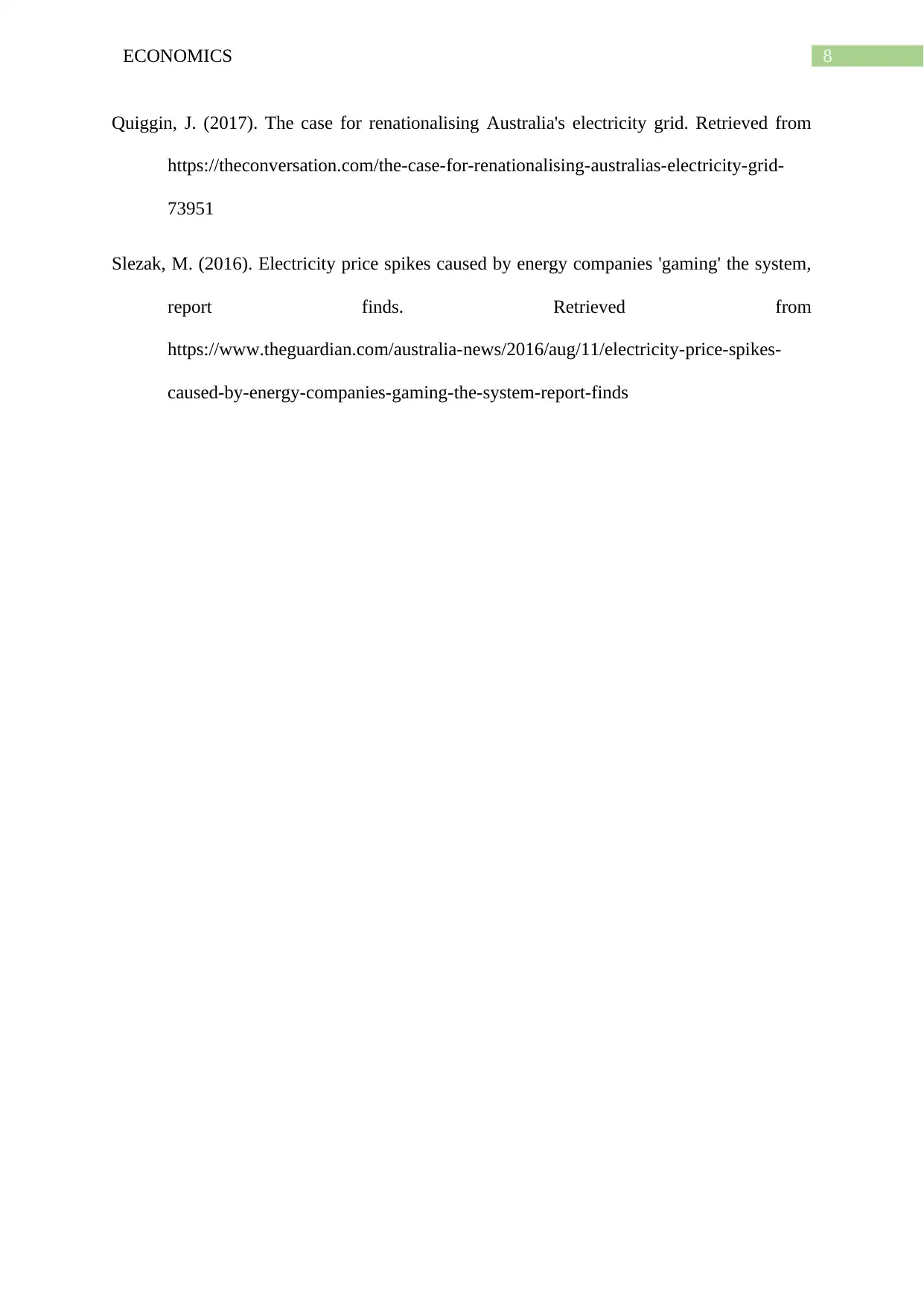
8ECONOMICS
Quiggin, J. (2017). The case for renationalising Australia's electricity grid. Retrieved from
https://theconversation.com/the-case-for-renationalising-australias-electricity-grid-
73951
Slezak, M. (2016). Electricity price spikes caused by energy companies 'gaming' the system,
report finds. Retrieved from
https://www.theguardian.com/australia-news/2016/aug/11/electricity-price-spikes-
caused-by-energy-companies-gaming-the-system-report-finds
Quiggin, J. (2017). The case for renationalising Australia's electricity grid. Retrieved from
https://theconversation.com/the-case-for-renationalising-australias-electricity-grid-
73951
Slezak, M. (2016). Electricity price spikes caused by energy companies 'gaming' the system,
report finds. Retrieved from
https://www.theguardian.com/australia-news/2016/aug/11/electricity-price-spikes-
caused-by-energy-companies-gaming-the-system-report-finds
⊘ This is a preview!⊘
Do you want full access?
Subscribe today to unlock all pages.

Trusted by 1+ million students worldwide
1 out of 9
Related Documents
Your All-in-One AI-Powered Toolkit for Academic Success.
+13062052269
info@desklib.com
Available 24*7 on WhatsApp / Email
![[object Object]](/_next/static/media/star-bottom.7253800d.svg)
Unlock your academic potential
Copyright © 2020–2026 A2Z Services. All Rights Reserved. Developed and managed by ZUCOL.





